
Production and Characterization of Bio-Briquettes Derived from Torrefied Cocoa Pod Husk and Durian Peel
Aldillah Herlambang, Imo Lolona Boangmanalu, Faiza Tursida, Arief Budiman, Hersandy Dayu Kusuma, and Andri Saputra*
Published Date : February 24, 2025
DOI : https://doi.org/10.12982/NLSC.2025.032
Journal Issues : Number 2, April-June 2025
Abstract The utilization of agricultural waste as a renewable energy source has gained significant attention in addressing environmental and energy challenges. The durian peel and cocoa pod husk as agriculture waste is widely found in Indonesia and could be used as bio-briquette sources. The purpose of this research is to produce and evaluate the physicochemical and energetic characteristics of briquette fuel derived from a blend of durian peel and cocoa pod husk. The process of preparing briquettes involved drying, torrefying, crushing, mixing with a binder, compacting, and finally drying the resulting briquettes. Proximate analysis, differential scanning calorimetry analysis, energetic analysis, and infrared spectroscopy analysis were used to characterize the briquettes that were formed. The study revealed that the bio-briquette produced from cocoa pod husk had a moisture content of 9.78%, ash content of 28.32%, volatile content of 29.41%, and fixed carbon of 32.49%. Conversely, the bio-briquette made from durian peel had a moisture content of 7.06%, ash content of 10.47%, volatile content of 34.94%, and fixed carbon of 47.53%. The calorific value of the durian peel bio-briquette exceeded that of the cocoa pod husk bio-briquette, measuring 6,448 cal/g and 4,872 cal/g, respectively. The combination of 45% durian peel and 45% cocoa pod husk increased the calorific value of the bio-briquette to 6,634 cal/g. The bio-briquettes produced in this study were found to be satisfactory for fuel energy. The economic analysis value according to the break-even point is reached or payback period (PP) within 3.46 years with an annual production capacity of 1,875,000 kg.
Keywords: Bio-briquette, Cocoa pod husk, Durian peel, Torrefaction, Agriculture waste
Citation: Herlambang, A., Boangmanalu, I. L., Tursida, F., Budiman,A., Kusuma, H. D., and Saputra, A. 2025. Production and characterization of bio-briquettes derived from torrefied cocoa pod husk and durian peel. Natural and Life Sciences Communications. 24(2): e2025032.
INTRODUCTION
Currently, the availability of resources plays a crucial role in enabling high shares of biomass to enter the energy markets. Globally, biomass fuel has become more attractive as a competitive substitute for fossil fuels due to the rising demand for clean energy (Ben-Iwo et al., 2016). In developing countries, there was a growing interest in utilizing agriculture waste for energy generation in the form of bio-briquettes (Brunerová et al., 2017). Significant amounts of agricultural waste were previously left unused or allowed to decompose, leading to serious environmental issues (Agbede and Oyewumi 2023). Nevertheless, these challenges could be addressed by producing bio-briquettes that are cost-effective, renewable, and sustainable (Sanchez et al., 2022). The benefits associated with using biomass bio-briquettes included being cost-effective, sourced from renewable sources, devoid of sulfur thus posing no environmental pollution risks, having higher calorific values compared to other solid fuel sources, exhibiting lower ash content compared to coal, and offering higher combustion efficiency due to lower moisture content and higher density compared to firewood (Sharma et al., 2015).Agricultural residues that underwent characterization, assessment, and bio-briquette production included durian peel combined with coconut and palm shell biomass (Sari et al., 2018), durian peel (Irhamni et al., 2019), durian peel with bagasse (Haryati et al., 2018), cacao pod husk (Brunerová et al., 2017; Tuates et al., 2018), cacao pod husk in combination with rice straw charcoal (Damayanti et al., 2020), rice husks, coffee husks, and groundnut shells (Lubwama et al., 2020), coffee husks, and rice husks (Lubwama et al., 2022), cassava peels (Ki et al. 2013), banana peel, and corn husk (Kapen et al., 2021), empty fruit bunches in the palm (Udoetok 2012), sugarcane bagasse, banana peels, coconut shells, and rattan waste (Bôt et al., 2021), and orange bagasse (Zanella et al., 2016). Residual materials were selected based on their qualities to produce briquette fuel such as their availability and chemical composition, low moisture and ash contents, high density, high calorific value, and moderate fixed carbon content. Besides the selection of material types, particle size and binder could affect the physical properties and calorific value of biobriquette (Trubetskaya et al., 2019; Trubetskaya et al., 2020).
This study was part of the ongoing efforts applied to the production and characterization of briquette fuel using a combination of cocoa pod husk and durian peel. Combining two or more biomass produced enhanced physical and chemical properties, increased combustibility, and durable briquettes (Okot, 2019). In addition, with the current cacao production in the country, around 3,382 metric tons of cacao pod husk are wasted every year. Durian (Durio zibethinus Murr) was an increasingly popular tropical fruit around the world, accounting for more than 1.6 tons of production each year. As a result, approximately 0.72 million tons of durian peel were commonly discharged after consumption (Liu et al., 2021). These residues represented potential feedstock materials for bio-briquette production.
This study had two objectives. Firstly, it prepared bio-briquette fuel from durian peel and cocoa pod husk by using the conventional procedure. This method worked as an upgraded technology, raising the calorific content of solid biomass through controlled heating at 200–300 °C using torrefaction (Sarker et al., 2021). Torrefaction led to the breakdown of hemicellulose, cellulose, and lignin devolatilization at various temperature stages (Chen et al., 2021; Kusuma et al., 2021), altering the biomass structure to improve grindability, O/C and H/C ratio, hydrophobicity, and energy density, thereby facilitating combustion, transport, and storage of the solid product (Niu et al., 2019). The primary focus of this study was to evaluate the viability of utilizing a blend of cocoa pod husk and durian peel for briquetting, aiming to provide an eco-friendly alternative energy source suitable for both households and industries.
MATERIAL AND METHODS
Materials
The materials used include cocoa peel, durian peel, and tapioca flour. The pyrolysis reactor and the bio-briquette hydraulic press machine setup are illustrated in Figure 1 and Figure 2, respectively.
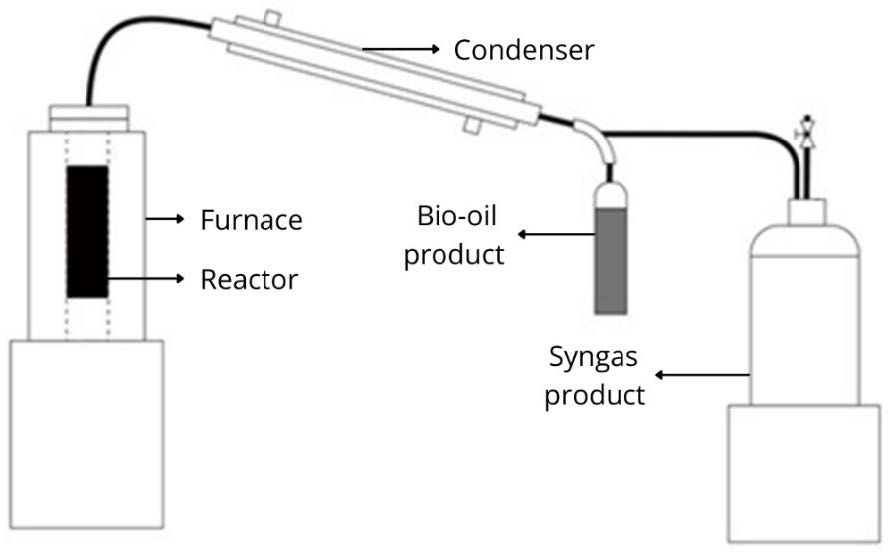
Figure 1. Pyrolysis reactor setup.
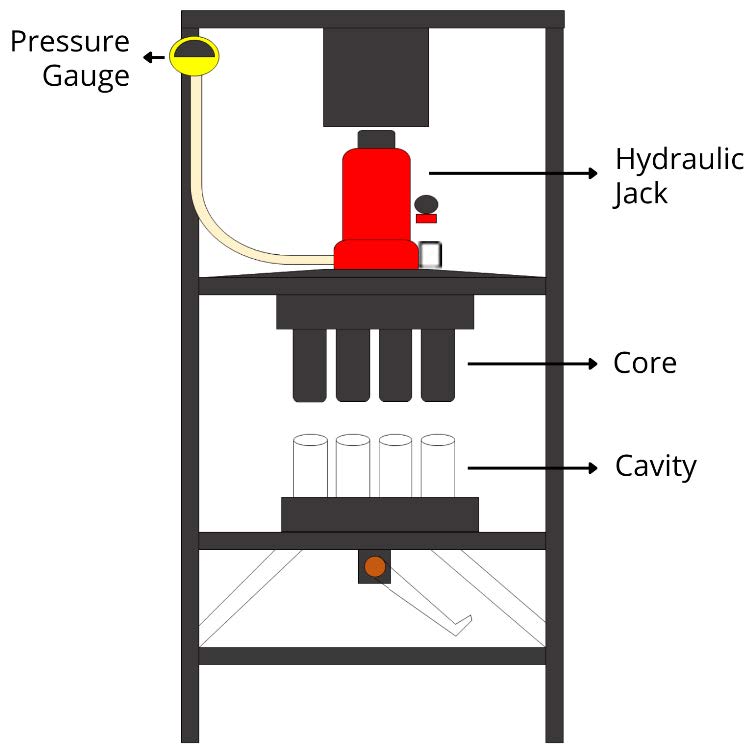
Figure 2. Bio-briquette hydraulic press machine setup.
Synthesis of bio-briquettes
Cocoa peel was weighed at 2.5 kg and torrefied in a slow pyrolysis reactor at 300°C for a day with a heating rate of 50°C/min (Sanchez et al., 2022). The torrefaction process produced char. The char was milled using a mill machine and sieved using a sieve (60 mesh). The same torrefaction procedure was also applied to durian peel. The cocoa pod husk, durian peels, and tapioca flour (as a binder) were mixed following the weight ratio in Table 1 to produce bio-briquettes. The bio-briquettes were densified and molded using a hydraulic press machine into solid cylindrical shapes. The bio-briquettes were then dried in an oven at 100°C for 15 minutes to reduce water content and strengthen char and tapioca flour bonds.
Table 1. Raw material ratio of bio-briquette.
|
Sample |
Process |
CPC (%w) |
DPC (%w) |
Tapioca flour (%w) |
|
C90D0 |
Without torrefaction |
90 |
0 |
10 |
|
C0D90 |
0 |
90 |
10 |
|
|
C90D0 |
With torrefaction |
90 |
0 |
10 |
|
C0D90 |
0 |
90 |
10 |
|
|
C45D45 |
45 |
45 |
10 |
|
|
C60D30 |
60 |
30 |
10 |
|
|
C75D15 |
75 |
15 |
10 |
Note: C = Cocoa pod husk; D = Durian peel
Characterization of bio-briquettes
The non-torrefied cocoa pod husk and durian peels, as well as the torrefied cocoa pod husk and durian peels, were analyzed to determine their proximal properties (moisture content, volatile matter, fixed carbon, and ash content). The proximal analysis was performed in the Chemical Engineering Laboratory of Lampung University, Indonesia following the standard of ASTM E1756-08. The calorific value of bio-briquettes also was performed in the Chemical Engineering Laboratory of Lampung University, Indonesia by a Differential scanning calorimeter (DSC) 4000 PerkinElmer (Massachusetts) and identified the functional groups of bio-briquette using Fourier-transform infrared (FTIR) spectroscopy Frontier C96600 PerkinElmer (Massachusetts).
RESULTS
Proximate analysis
The quality of briquettes relied on both the raw materials and the briquetting process. Combustion or thermal properties were primarily determined by the characteristics of the raw material. Combustion was assessed through parameters like calorific value and proximate analysis (Sanchez et al., 2022). Table 2 provides a summary of the proximate properties experiment results (fixed carbon, volatile matter, ash content, and moisture content). The torrefaction treatment to the cocoa pod husk and durian peel has a significant effect in obtaining the fix charbon about 32.49 and 47.53 respectively to non-torrefaction treatment.
Table 2. Proximate properties of torrefied and non-torrefied cocoa pod husk and durian peel.
|
Sample |
MC (%) |
AC (%) |
VM (%) |
FC (%) |
|
Non-torrefied cocoa pod husk |
65.84 |
12.87 |
13.69 |
7.60 |
|
Non-torrefied durian peel |
67.49 |
5.22 |
19.47 |
7.82 |
|
Torrefied cocoa pod husk |
9.78 |
28.32 |
29.41 |
32.49 |
|
Torrefied durian peel |
7.06 |
10.47 |
34.94 |
47.53 |
Note: FC: Fixed Carbon; VM: Volatile Matter; AC: Ash Content; MC: Moisture Content
Bio-briquettes characterization
FTIR spectra depicting cocoa pod husk bio-briquette and durian peel bio-briquette are displayed in Figure 3. The results indicated identical functional groups in both cocoa pod husk bio-briquette and durian peel bio-briquette. For instance, a broad peak at 3,300 cm-1 was assigned to the presence of O-H bonds. A peak observed at 1,563 cm-1 indicated stretching of the aromatic C=C in bio-briquettes (Liu et al., 2020; Kusuma et al., 2022). Additionally, the peak at 1,370 cm-1 and 1,024 cm-1 corresponded to the deformation of aliphatic CHx and the stretching of aliphatic C-O in bio-briquettes, respectively (Adjin-Tetteh et al., 2018; Cadd et al., 2020; Janyasupab et al., 2023). The presence of OH, C=C, C-O, and CHx groups indicated that both cocoa pod husk bio-briquette and durian peel bio-briquette were of good quality ecological charcoals, affirming the success of the derivation process, as stated by Akam et al. (2024).
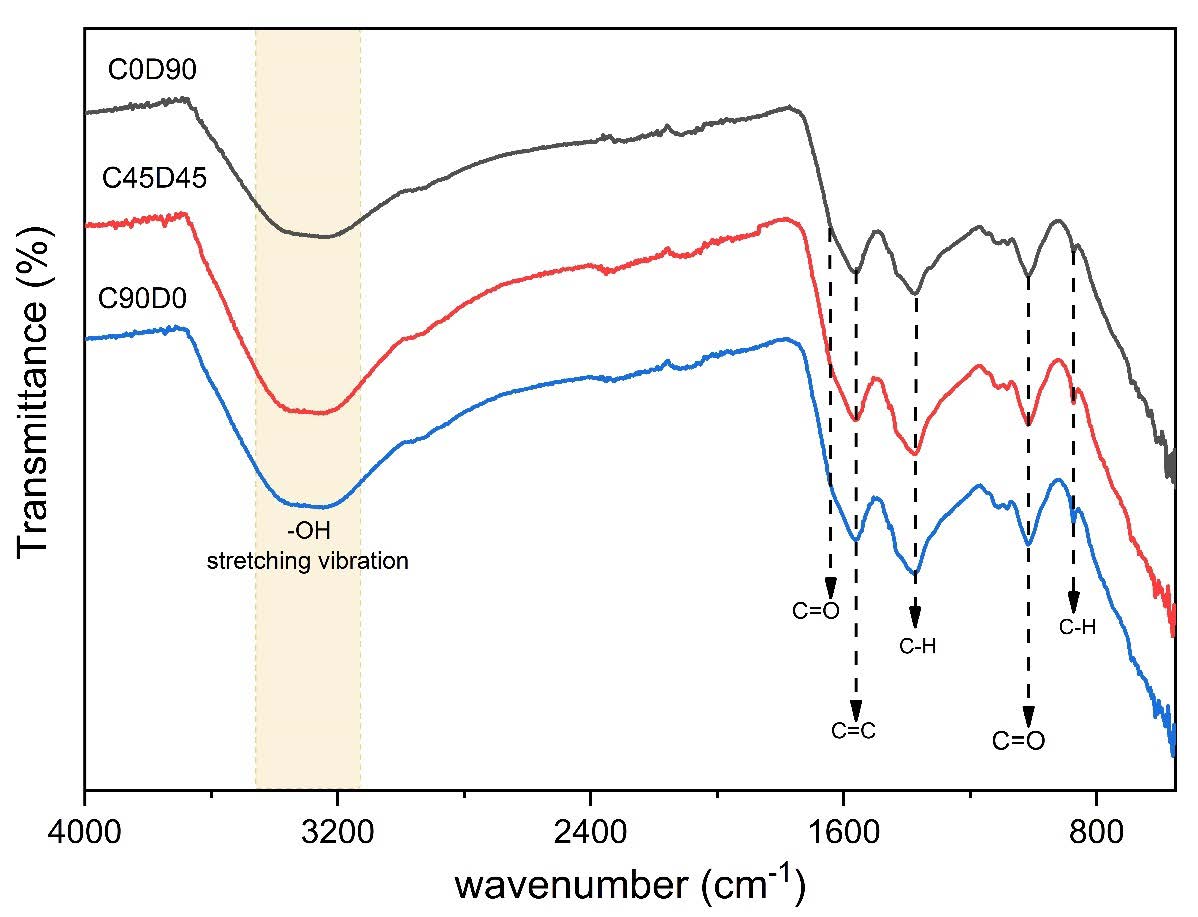
Figure 3. FTIR spectra of bio-briquette.
Bio-briquettes performance
Figure 4 depicted the DSC, which assessed the amount of energy absorbed or released by a sample during cooling or heating. The DSC depicted when the biomass sample started losing weight and the highest temperature at which the most weight was lost (Titiloye et al., 2013). The DSC curve of cocoa pod husk bio-briquette and durian peel bio-briquette exhibited two endothermic peaks at 78°C and 123°C. The loss of mass at 78°C was attributed to the thermal evaporation of volatile matter in the bio-briquettes, aligning with the results of the proximate analysis of volatile matter presented in Table 2. A minor amount of water, anticipated to evaporate based on the moisture content analysis in Table 2, was observed at the endothermic peak at 123°C. The thermal decomposition of cellulose typically observed at 270-310°C was not evident in the DSC curve (Bampenrat et al., 2020). This finding suggests that the torrefaction process at 300°C has fully decomposed cellulose in cocoa pods and durian peels. Furthermore, the thermal decomposition of lignin usually observed at the endothermic peak at 250-500 °C was absent in the DSC curve (Nikolaeva and Solovev, 2021). This outcome indicates that the bio-briquettes do not contain lignin, as it is inferred that lignin has been decomposed by the torrefaction process. Thus, the DSC curve revealed bio-briquettes have a high thermal stability. The calorific values of the bio-briquettes acquired in this study were depicted in Figure 5 and Figure 6. The torrefaction treatment to the bio-briquettes has a higher energy than the non-torrefaction treatment. The highest bio-briquette energy is obtained in the combination of 45% cocoa pod husk and 45% durian peel mass ratio.
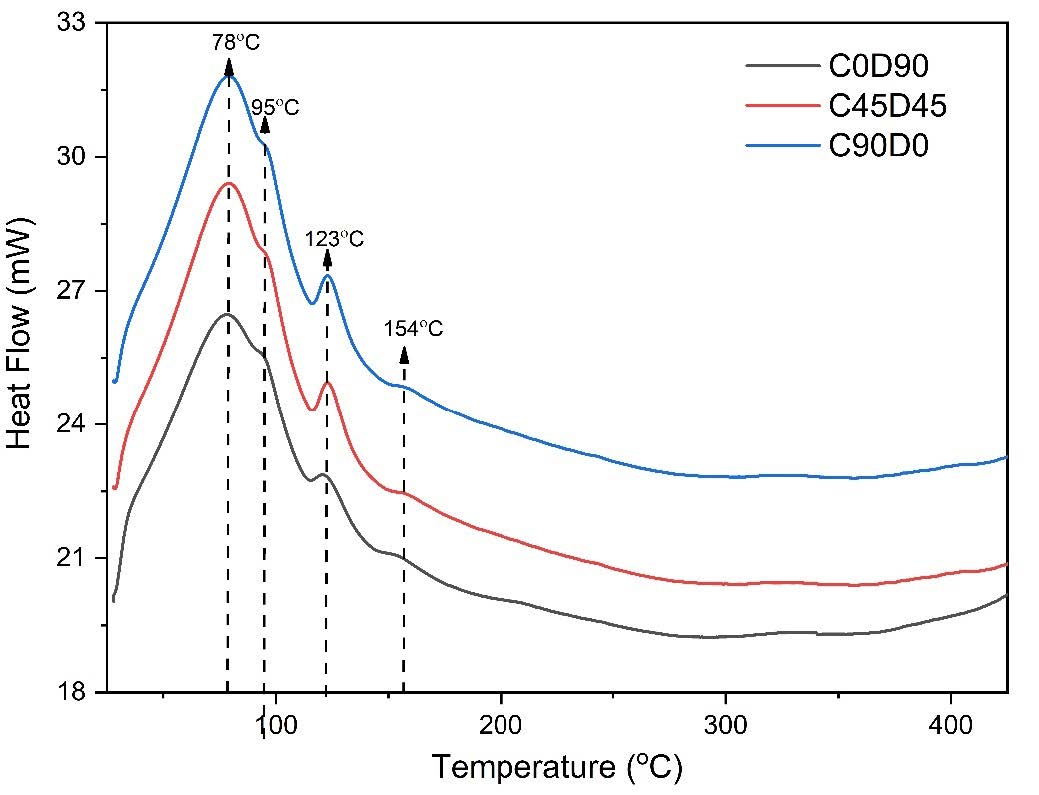
Figure 4. DSC curve of bio-briquette.
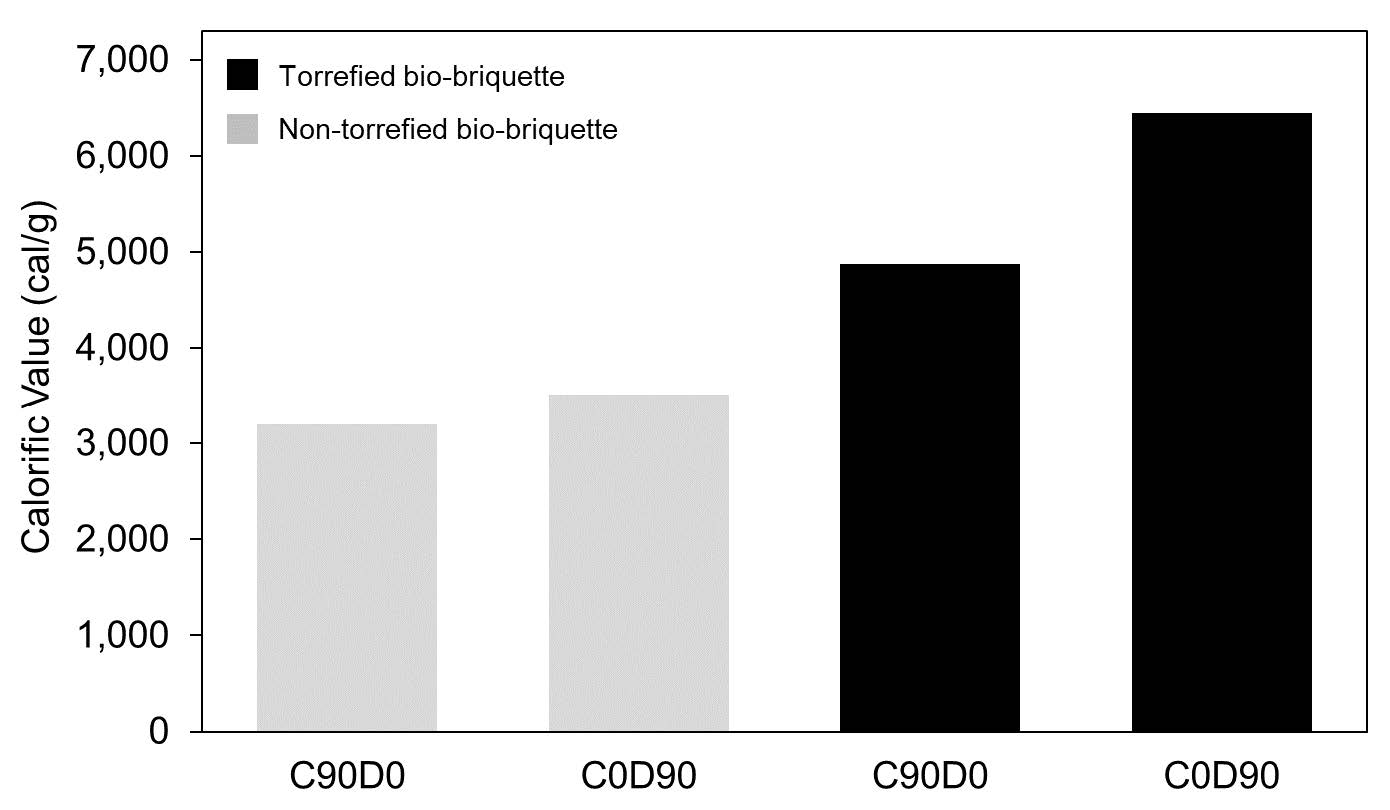
Figure 5. Calorific value of torrefied and non-torrefied bio-briquettes.
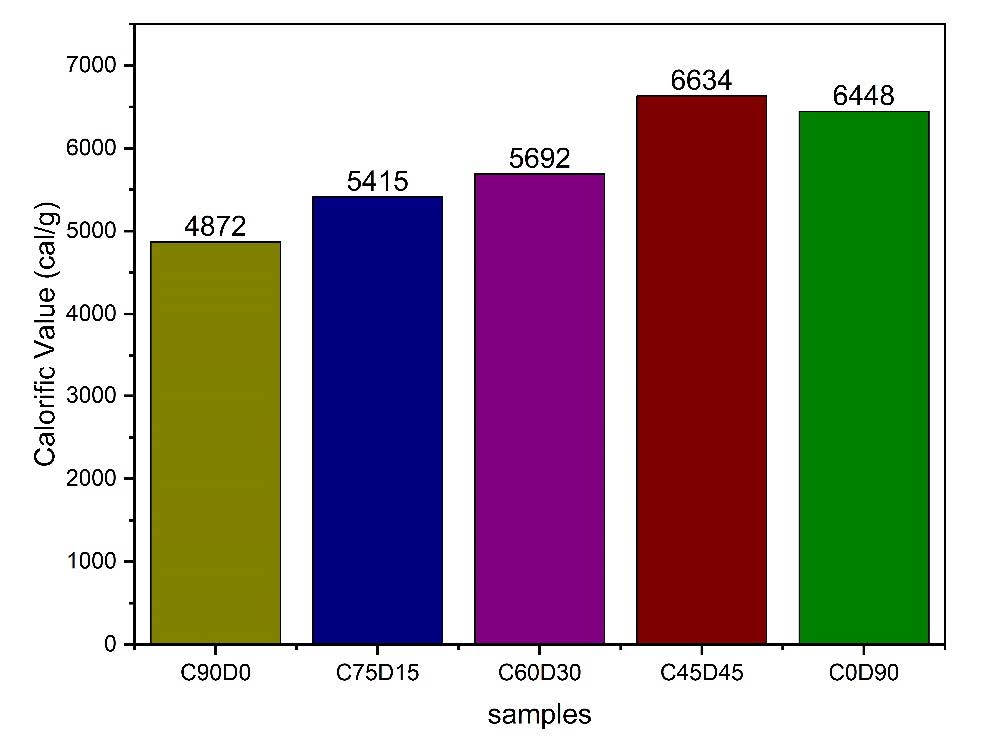
Figure 6. Calorific value of various torrefied bio-briquettes.
Economic feasibility study
This economic feasibility study of bio-briquette production uses several assumptions as tabulated in Table 3. The production machinery used in the economic calculation consists of chopper, torefaction reactor, scales, grinder, screening, screw press briquette, oven, packing machine, and test laboratory equipment. The main raw materials used are durian peel waste (IDR 500) and cocoa shell waste (IDR 500) obtained from smallholder plantations, and using tapioca flour binder. Data and calculations of production cost components are tabulated in Table 4. Production cost components consist of investment cost (IDR 4,966,020,000), fixed cost (IDR 618,730,000), and variable cost (IDR 479,213,058). Based on the calculation, it is known that the cost of goods manufactured is IDR 14,639 per kg. The cost of goods manufactured is still within the range of global briquette market prices. The price of briquettes in Indonesia ranges from IDR 10,000 - 20,000 per kg (Sutisna et al., 2021), the bio-briquettes evaluated in this study exhibit competitive pricing and quality relative to market briquettes.
Tabel 3. Assumptions used in the economic feasibility study.
|
Project economic life |
10 years |
|
Economic life of equipment |
10 years |
|
Economic life of utilities |
5 years |
|
Building aftermarket value |
50 % of initial value |
|
Land aftermarket value |
100 % of initial value |
|
Equipment aftermarket value |
10 % of initial value |
|
Equipment maintenance costs |
10 % of initial value |
|
Insurance costs |
0.5 % of initial value |
|
Discount factor |
12% |
|
Corporate income tax |
25% |
|
Land and building tax |
0.2% |
|
Vehicle tax |
1.5% |
|
Credit payment |
Sliding rate |
|
Process capacity |
250 kg/day |
|
Working hours per year |
7,500 days |
|
Machine maintenance |
65 days |
Tabel 4. Cost component calculation summary.
|
Cost component |
Value (IDR) |
|
4,966,020,000 |
|
Pre-investment |
230,000,000 |
|
Land and building |
1,630,000,000 |
|
Supporting facilities |
109,000,000 |
|
Machinery, laboratory equipment, and utilities |
578,000,000 |
|
Office equipment |
19,000,000 |
|
Vehicle |
275,000,000 |
|
Contingency (10% of total fixed capital) |
284,100,000 |
|
Interest during construction (12% of fixed investment) |
340,920,000 |
|
Total working capital |
1,500,000,000 |
|
618,730,000 |
|
Indirect labor |
300,000,000 |
|
Administration |
9,750,000 |
|
Marketing and distribution |
15,000,000 |
|
Maintenance (insurance and depreciation) |
293,980,000 |
|
479,213,058 |
|
Direct labor |
168,000,000 |
|
Raw material |
155,713,058 |
|
Utility |
135,500,000 |
|
Packaging |
20,000,000 |
|
Production cost |
1,097,943,058 |
|
Cost of goods manufactured |
14,639 |
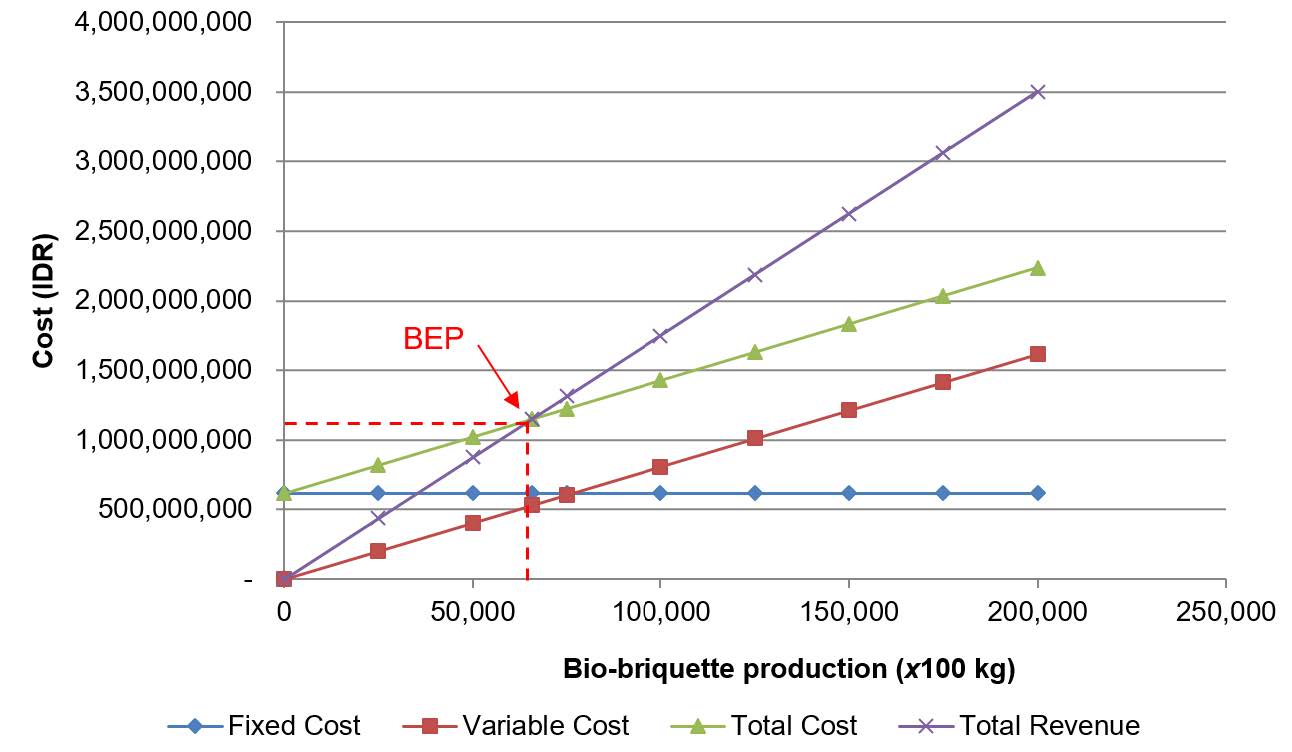
Figure 7. Break-even point analysis.
DISCUSSION
Proximate analysis
The Bio-briquettes were synthesized by combining of durian peel and cocoa pod husk using torrefaction method. Tapioca flour was used as a binder because it is commonly used as a natural binder in bio-briquette production due to its strong adhesive properties and biodegradability (Simatupang and Simbolon, 2023; Seetapong et al., 2024). It helps in enhancing the mechanical strength and durability of the briquettes while also improving combustion efficiency by ensuring uniformity in shape and density. For the proximate analysis, Moisture content refers to the proportion of water mass in a briquette sample before and after drying. This parameter influences the combustion process, as the generated heat is initially utilized to evaporate the water (Suryaningsih et al., 2018). Torrefaction decreased the moisture content of both durian peels and cocoa pod husks, as indicated in Table 2. The moisture content of durian peels decreased after torrefaction from 67.49% to 7.06%. Similarly, the moisture content of cocoa pod husk decreased after torrefaction from 65.84% to 9.78%. The temperature used during torrefaction was approximately 300°C. As the temperature exceeded the boiling point of water, the water molecules present in durian peels and cocoa pod husks evaporated. The higher torrefaction temperature, the greater the heat absorbed, resulting in more efficient evaporation of water molecules (Ganing et al., 2021). The absorption of water vapor by bio-briquettes commenced once torrefaction concluded. During the cooling process of the charcoal, water vapor became trapped within the charcoal's pores. Consequently, the water in torrefied durian peel and cocoa pod husk was not completely removed or reduced to close to 0%.
The findings of this study are supported by Damayanti et al. (2020), who obtained a similar moisture content for cocoa pod husk briquette, specifically 8.05%, through pyrolysis at 400-500°C. This result aligns closely with the findings of Akam et al. (2024), who reported a moisture content of 10.50% through pyrolysis at 550°C. Because of the water vapor produced during the briquetting process, excessive moisture can present an explosion risk; therefore, overly dry biomass can hinder briquette cohesion (de Oliveira Maia et al., 2018). The results of this study are in line with previous research, as mentioned by Canales-Flores and Prieto-García (Canales-Flores and Prieto-García, 2016), who found that high moisture content (>40%) slows down the rate of heating and lengthens the time needed to achieve the process temperature. Additionally, residues typically have a moisture content ranging from 7% to 13%, therefore they are ideal for thermal conversion methods like direct combustion (Zinla et al., 2021).
Ash content refers to the mass of non-combustible material left behind following the combustion of the biomass sample at 550°C. A higher ash content indicates a lower calorific value, making combustion more difficult (Ifa et al., 2020). Torrefaction increased the percentage of ash content in durian peels and cocoa pod husks, as observed in Table 2. The ash content of durian peel charcoal increased after torrefaction from 5.22% to 10.47%. This result exceeded the literature value of 7.70% (Irhamni et al., 2019). Similarly, the ash content of cocoa pod husk charcoal increased after torrefaction from 12.87% to 28.32%, surpassing the literature value of 7.48% (Damayanti et al., 2020). Following roasting, the biomass still contained high concentrations of inorganic elements for example silicon, calcium, and potassium (Ofori and Akoto, 2020). These inorganic elements could not be burned or decomposed at 300°C through slow pyrolysis or torrefaction methods, potentially contributing to the high ash content. Supposedly, the high ash content was due to the high concentration of inorganic compounds, which may inherently have a catalytic effect on thermal conversion technologies. A high ash content reduced oxygen diffusion in carbonized fuel and the thermal conductivity, resulting in increased abrasion and corrosion (Ruiz Aquino et al., 2019).
Volatile matter represents material that is inherently unstable, prone to transitioning rapidly between states or vaporizing, expressed as a percentage. It encompasses substances lost during heating of the sample in a furnace for 7 minutes at 900°C. Higher volatile content in bio-briquettes facilitates easier combustion (Ifa et al., 2020). However, a high volatile matter value can compromise briquette quality by reducing fixed carbon content, impacting the generated calorific value, and increasing smoke production during burning (Idris et al., 2018). Elevated volatile matter content leads to lower ignition and temperature, quicker ignition, devolatilization, and burning, increased production of combustible gas and inorganic vapor, as well as enhanced burnout with lower unburned carbon in ash due to improved combustion (Tuates et al., 2018). Torrefaction not only increased the percentage of ash content but also increased the percentage of volatile matter in both durian peel and cocoa pod husk charcoal. The volatile matter of durian peel charcoal increased after torrefaction from 19.47% to 34.94%. Similarly, the volatile matter of cocoa pod husk charcoal increased after torrefaction from 13.69% to 29.41%. These results closely aligned with some literature values: 34.7% and 31.5% (Akam et al., 2024), but were lower than 64.69% (Tuates et al., 2018), and 75.18% (Damayanti et al., 2020).
Higher volatility of fuel corresponds to faster combustion and increased reactivity to ignition. Therefore, slower combustion is favored for domestic cooking, suggesting that the fuel generated will burn at a slower rate and be less reactive, making it ideal for household use. Additionally, an increase in volatile matter enhances quicker ignition and burning as noted by Heya et al. (2014), who suggest that volatiles enhance charcoal combustion, resulting in a cleaner burn. As a result, burning with less volatile stuff is resource-efficient and ecologically benign. This study clarifies further how the high emissions of volatile compounds during combustion lead to the formation of pollutants and a decline in air quality, which has an adverse effect on ecosystems and the environment. As a result, the positive study outcome suggests that the briquettes will burn slowly and cause the least amount of pollution to the environment.
Fixed carbon refers to the proportion of carbon that is chemically bonded within the briquettes, expressed as a percentage. It indicates the residue remaining after 100% reduction of the sample, accounting for moisture content, volatile matter, and ash content.
A higher level of bound carbon correlates with an increase in the calorific value (Ifa et al., 2020) Conversely, during biomass conversion, fuels with lower levels of fixed carbon contribute to reduced carbon dioxide emissions. However, the primary environmental advantage of biomass fuel lies in the consideration of carbon dioxide emissions from biofuels as CO2-neutral in terms of the greenhouse gas effect (Vassilev et al., 2015).
Torrefaction increased the percentage of fixed carbon in both durian peels and cocoa pod husk, as observed in Table 2. The fixed carbon content of durian peel increased after torrefaction from 7.80% to 47.53%. Similarly, the fixed carbon content of cocoa pod husk increased after torrefaction from 7.60% to 32.49%. These results exceeded some literature values: 29.69%, 9.29%, and 10.61% but were lower than 59.50% and 58.8% (Ofori and Akoto, 2020; Zinla et al., 2021). Torrefaction at 300°C caused decomposition and evaporation of moisture content in the feedstock, resulting in higher carbon content (Alam, 2022). Compared to fuels with low fixed carbon concentration, materials having a greater fixed carbon content burn more slowly and require a longer time to burn (Brunerová et al., 2017). Combustion residues with lower fixed carbon amounts are processed more quickly than coal, but they're harder to control (Zinla et al., 2021). Fixed carbon is a crucial parameter directly reflecting the biomass feedstock's potential energy. Therefore, the feedstock's higher calorific value corresponds with its higher fixed carbon content. Higher fixed carbon content causes more heat to be produced during burning since solid carbon is the main source of heat for combustion (Akowuah et al., 2012). For industrial applications, the European market usually requires fixed carbon levels above 75%; however, values below 75% are acceptable for non-industrial uses, like smoking and cooking (Lohani et al., 2024; Nonsawang et al., 2024).
Bio-briquettes performance
The DSC curve of cocoa pod husk bio-briquette and durian peel bio-briquette exhibited two endothermic peaks at 78°C and 123°C. The loss of mass at 78°C was attributed to the thermal evaporation of volatile matter in the bio-briquettes, aligning with the results of the proximate analysis of volatile matter presented in Table 2. A minor amount of water, anticipated to evaporate based on the moisture content analysis in Table 2, was observed at the endothermic peak at 123°C. The thermal decomposition of cellulose typically observed at 270-310 °C was not evident in the DSC curve (Bampenrat et al., 2020). This finding suggests that the torrefaction process at 300°C has fully decomposed cellulose in cocoa pods and durian peels. Furthermore, the thermal decomposition of lignin usually observed at the endothermic peak at 250-500 °C was absent in the DSC curve (Nikolaeva and Solovev 2021). This outcome indicates that the bio-briquettes do not contain lignin, as it is inferred that lignin has been decomposed by the torrefaction process. Thus, the DSC curve revealed bio-briquettes have a high thermal stability.
The calorific value indicated the energy contained in a briquette (Suryaningsih et al., 2018). Good-quality bio-briquettes were characterized by a high calorific value (Sanchez et al., 2022). In Figure 5, it was demonstrated that the calorific value of bio-briquettes from both biomass sources rose post-torrefaction, with cocoa pod husk increasing from 3,203 cal/g to 4,872 cal/g and durian peels from 3,510 cal/g to 6,448 cal/g. Torrefaction at 300°C eliminated water, decreased moisture content, and heightened fixed carbon content in biomass, consequently elevating the calorific value of bio-briquettes.
Although the bio-briquettes generated in this study underwent torrefaction at 300°C, their calorific value surpassed that of some literature bio-briquettes produced through pyrolysis at higher temperatures. For instance, durian peels pyrolyzed at 350°C yielded a bio-briquette with a calorific value of 6,157 cal/g (Haryati et al., 2018). Additionally, a blend of durian peels and coconut shells pyrolyzed at 400°C resulted in a bio-briquette with a calorific value of 6,040 cal/g (Sari et al., 2018). Similarly, durian peels pyrolyzed at 350°C produced a bio-briquette with a calorific value of 6,274 cal/g (Nuriana et al., 2014).
The calorific value of the bio-briquette from cocoa pod husk obtained in this study exceeded that reported by Akam et al. (2024), and fell short of the value reported by Yirijor et al. (2022). Cocoa pod husk carbonized at 550°C yielded a bio-briquette with a calorific value of 4,285 cal/g. In contrast, cocoa pod husk carbonized at 400°C resulted in a bio-briquette with a calorific value of 5,577 cal/g (Yirijor et al., 2022). The high moisture content of the raw material may be responsible for the value difference. Akam et al. (2024) noted higher moisture levels in the feedstock result in more significant energy dissipation during thermochemical conversion. As a result, bio-briquette with a lower moisture content generates more heat and energy.
The calorific value of bio-briquettes from durian peels surpassed that of bio-briquettes from cocoa pod husk, as illustrated in Figure 6. These findings corroborate with some literature values (Haryati et al., 2018; Sari et al., 2018; Yirijor et al., 2022; Akam et al., 2024). Bio-briquette blends containing a higher proportion of durian peels exhibited increased calorific value. The calorific value of bio-briquette blends fell within the range of values observed for durian peels and cocoa pod husk, except for sample C45D45. The highest calorific value recorded in this study was attained by a blend consisting of 45% cocoa pod husk and 45% durian peels, proving to be satisfactory for fuel energy, as stated by Akam et al. (2024).
Economic Feasibility Study
The break-even point (BEP) analysis illustrated in Figure 7 demonstrates that economic feasibility for bio-briquette production is achieved at a production level of 6,500,728 kg, corresponding to a production capacity of 250 kg/day. Assuming 7,500 working hours annually, the annual production capacity is 1,875,000 kg, and the BEP value is reached or payback period (PP) within 3.46 years. This finding highlights the scalability and economic potential of bio-briquette production as a renewable energy source. The data underscores the critical importance of maintaining cost efficiency in both fixed and variable costs to achieve profitability within a reasonable timeframe. The linear trends of fixed costs, variable costs, total costs, and total revenue demonstrate the balance required to achieve breakeven. By leveraging a sustainable and efficient production model, bio-briquettes can provide an economically viable alternative to conventional energy sources.
CONCLUSIONS
The aim of this study was to produce bio-briquettes derived from agriculture waste such as durian peel and cocoa pod husk by torrefaction process, followed by analyzing their physicochemical, energetic, and thermal attributes. Thermal characterization showed bio-briquettes possess significant thermal resilience and the most significant reduction in mass resulting from the thermal evaporation of volatile substances. The combination of 45% durian peel and 45% cocoa pod husk increased the calorific value of the bio-briquette to 6,634 cal/g. The bio-briquettes produced in this study were found to be satisfactory for fuel energy. The break-even point (BEP) analysis value is reached or payback period (PP) within 3.46 years with annual production capacity is 1,875,000 kg. This finding highlights the scalability and economic potential of bio-briquette production as alternative to conventional energy sources.
AUTHOR CONTRIBUTIONS
All of the authors have contributed to the manuscript
CONFLICT OF INTEREST
The authors declare that they hold no competing interests.
REFERENCES
Adjin-Tetteh, M., Asiedu, N., Dodoo-Arhin, D., Karam, A., and Amaniampong, P.N. 2018. Thermochemical conversion and characterization of cocoa pod husks a potential agricultural waste from Ghana. Industrial Crops and Products. 119: 304-312.
Agbede, T.M. and Oyewumi, A. 2023. Effects of biochar and poultry manure amendments on soil physical and chemical properties, growth and sweet potato yield in degraded alfisols of humid tropics. Natural and Life Sciences Communications. 22(2): e2023023.
Akam, N.G., Diboma, B.S., Mfomo, J.Z., Ndiwe, B., Bôt, B.V., and Biwôlé, A.B. 2024. Physicochemical characterization of briquette fuel produced from cocoa pod husk case of Cameroon. Energy Reports. 11: 1580-1589.
Akowuah, J.O., Kemausuor, F., and Mitchual, S.J. 2012. Physico-chemical characteristics and market potential of sawdust charcoal briquette. International Journal of Energy and Environmental Engineering. 3(1): 20.
Alam, M.N. 2022. Pengaruh suhu pirolisis terhadap kadar fixed carbon dari karbon aktif kulit batang sagu. Cokroaminoto Journal of Chemical Science. 4(2): 19-22.
Bampenrat, A., Boonkitkoson, A., Seangwattana, T., Suttiarporn, P., and Sukkathanyawat, H. 2020. Kinetic analysis of durian rind pyrolysis using model-free method. IOP Conference Series: Earth and Environmental Science. 586: 012002.
Ben-Iwo, J., Manovic, V., and Longhurst P. 2016. Biomass resources and biofuels potential for the production of transportation fuels in Nigeria. Renewable and Sustainable Energy Reviews. 63: 172-192.
Bôt, B.V., Sosso, O.T., Tamba, J.G., Lekane, E., Bikai, J.L., and Ndamé, M.K. 2021. Preparation and characterization of biomass briquettes made from banana peels, sugarcane bagasse, coconut shells and rattan waste. Biomass Conversion and Biorefinery. 13: 7937-7946.
Brunerová, A., Roubík, H., Brožek, M., Herák, D., Šleger, V., and Mazancová, J. 2017. Potential of tropical fruit waste biomass for production of bio-briquette fuel: Using Indonesia as an example. Energies. 10(12): 2119.
Cadd, H.R., Tyler, J., Tibby, J., Baldock, J., Hawke, B., Barr, C., and Leng, M.J. 2020. The potential for rapid determination of charcoal from wetland sediments using infrared spectroscopy. Palaeogeography, Palaeoclimatology, Palaeoecology. 542: 109562.
Canales-Flores, R.A., and Prieto-García, F. 2016. Activation methods of carbonaceous materials obtained from agricultural waste. Chemistry & Biodiversity. 13(3): 261-268.
Chen, W.H., Fong Eng, C., Lin, Y.Y., Bach, Q.V., Ashokkumar, V., and Show, P.L. 2021. Two-step thermodegradation kinetics of cellulose, hemicelluloses, and lignin under isothermal torrefaction analyzed by particle swarm optimization. Energy Conversion and Management. 238: 114116.
Damayanti, R.W., Sandra, S., and Nanda, N.R. 2020. The effect of adding rice straw charcoal to the processing of bio-pellet from cacao pod husk. Advances in Food Science, Sustainable Agriculture and Agroindustrial Engineering. 3(2): 81-90.
Ganing, M., Suryanto, A., Sabara, Z., and Arman, M. 2021. Pemanfaatan daun ketapang kering dan kulit kakao menjadi briket sebagai bahan bakar alternatif. Journal of Chemical Process Engineering. 6(2): 74-82.
Haryati, S., Rahmatullah, R., and Putri, R.W. 2018. Torrefaction of durian peel and bagasse for bio-briquette as an alternative solid fuel. IOP Conference Series: Materials Science and Engineering. 334(1): 012008.
Heya, M., Foroughbakhch, R., Carrillo-Parra, A., and Colín-Urieta, S. 2014. Bioenergy potential of shrub from native species of northeastern Mexico. International Journal of Agricultural Policy and Research. 2: 475-483.
Idris, R., Yuliansyah. A.T., and Purwono, S. 2018. Development of biobriquette from nutmeg seed shells. E3S Web of Conferences. 42: 2016-2019.
Ifa, L., Yani, S., Nurjannah, N., Darnengsih, D., Rusnaenah, A., Mel, M., Mahfud, M., and Kusuma, H.S. 2020. Techno-economic analysis of bio-briquette from cashew nut shell waste. Heliyon. 6(9): e05009.
Irhamni, Saudah, Diana, Ernilasari, and Suzanni, M. A. 2019. Utilization of durian shell waste with Janeng Pati as a raw material of briquette for renewable energy. IOP Conference Series: Materials Science and Engineering. 536(1): 012078.
Janyasupab, P., Brix, H., and Jampeetong, A. 2023. Effects of longan biochar as filter materials on plant responses and wastewater treatment by Typha angustifolia L. Natural and Life Sciences Communications. 22(3): e2023035.
Kapen, P.T., Tenkeu, M.N., Yadjie, E., and Tchuen, G. 2021. Production and characterization of environmentally friendly charcoal briquettes obtained from agriculture waste: Case of Cameroon. International Journal of Environmental Science and Technology. 19: 5253-5260.
Ki, O.L., Kurniawan, A., Lin, C.X., Ju, Y.H., and Ismadji, S. 2013. Bio-oil from cassava peel: A potential renewable energy source. Bioresource Technology. 145: 157-161.
Kusuma, H.D., Rochmadi, Prasetyo, I., and Ariyanto, T. 2021. Mesoporous manganese oxide/lignin-derived carbon for high performance of supercapacitor electrodes. Molecules. 26(23): 7104.
Kusuma, H.D., Rochmadi, Swantomo, D., Prasetyo, I., and Ariyanto, T. 2022. Enhancing capacitive performance of lignin-derived carbon by Mn oxide loading. AIP Conference Proceedings. 2440(1): 30009.
Liu, H., Chen, T., and Fang, L. 2020. Evolution of char structure during non-isothermal low temperature pyrolysis of ZhunDong coal by microwave heating: A comparative study with conventional heating. Journal of the Energy Institute. 93(3): 1195-1206.
Liu, H., Liu, J., Huang, H., Evrendilek, F., Wen, S., and Li, W. 2021. Optimizing bioenergy and by-product outputs from durian shell pyrolysis. Renewable Energy. 164: 407-418.
Lohani, T.K., Seboka, Y., Biliso, W.B., Reza, S., and Jayaraman, D. 2024. An assessment of bamboo charcoal briquettes derived from the two main bamboo species in Ethiopia. Advances in Bamboo Science. 9: 100106.
Lubwama, M., Yiga, V.A., and Lubwama, H.N. 2022. Effects and interactions of the agricultural waste residues and binder type on physical properties and calorific values of carbonized briquettes. Biomass Conversion and Biorefinery. 12(11): 4979-4999.
Lubwama, M., Yiga, V.A., Muhairwe, F., and Kihedu, J. 2020. Physical and combustion properties of agricultural residue bio-char bio-composite briquettes as sustainable domestic energy sources. Renewable Energy. 148: 1002-1016.
Nikolaeva, L.A., and Solovev, T.M. 2021. Investigation of thermal properties of fuel briquettes by DSC method. IOP Conference Series: Earth and Environmental Science. 666(3): 032006.
Niu, Y., Lv, Y., Lei, Y., Liu, S., Liang, Y., Wang, D., and Hui, S. 2019. Biomass torrefaction: Properties, applications, challenges, and economy. Renewable and Sustainable Energy Reviews. 115: 109395.
Nonsawang, S., Juntahum, S., Sanchumpu, P., Suaili, W., Senawong, K., and Laloon, K. 2024. Unlocking renewable fuel: Charcoal briquettes production from agro-industrial waste with cassava industrial binders. Energy Reports. 12: 4966-4982.
Nuriana, W., Anisa, N., and Martana. 2014. Synthesis preliminary studies durian peel bio briquettes as an alternative fuels. Energy Procedia. 47: 295–302.
Ofori, P., and Akoto, O. 2020. Production and characterisation of briquettes from carbonised cocoa pod husk and sawdust. OALib. 07: 1-20.
Okot, D.K. 2019. Briquetting and torrefaction of agricultural residues for energy production. Ph.D. Dissertation. Newcastle University. Merz Court, Newcastle upon Tyne NE1 7RU, Britania Raya.
de Oliveira Maia, B.G., de Oliveira, A.P.N., de Oliveira, T.M.N., Marangoni, C., Souza, O., and Sellin, N. 2018. Characterization and production of banana crop and rice processing waste briquettes. Environmental Progress & Sustainable Energy. 37(4): 1266-1273.
Ruiz Aquino, F., Angel, S., Santiago-García, W., Fuente Carrasco, M., Castellanos, J.R., and Carrillo-Parra, A. 2019. Energy characteristics of wood and charcoal of selected tree species in Mexico. Wood Research. 64: 71-82.
Sanchez, P.D.C, Aspe, M.M., and Sindol, K.N. 2022. An overview on the production of bio-briquettes from agricultural wastes: Methods, processes, and quality. Journal of Agricultural and Food Engineering. 1: 0036.
Sari, E., Pasymi, Khatab, U., Desmiarti, R., Ariansyah, R., Hariadi, and Sutra. 2018. Studies of carbonization process on the production of durian peel biobriquettes with mixed biomass coconut and palm shells. IOP Conference Series: Materials Science and Engineering. 316(1): 012021.
Sarker, T.R., Nanda, S., Dalai, A.K., and Meda, V. 2021. A review of torrefaction technology for upgrading lignocellulosic biomass to solid biofuels. BioEnergy Research. 14(2): 645-669.
Seetapong, N., Mankaket, S., Rahem, S., Chanlert, P., and Chulok, S. 2024. Exploring binder efficacy in the fabrication of charcoal briquettes from palmyra palm and oil palm shells: A comprehensive analysis. BioResources. 19(3): 5047-5057.
Sharma, M.K., Priyank, G., and Sharma, N. 2015. Biomass briquette production: A propagation of non-convention technology and future of pollution free thermal energy sources. American Journal of Engineering Research. 4(02): 44-50.
Simatupang, D.F., and Simbolon. M. 2023. Fabrication of biobriquettes from mixture of palm fronds and palm shells with varying binders of tapioca and sago flour. International Journal of Applied Research and Sustainable Sciences. 1(4): 319-330.
Suryaningsih, S., Nurhilal, O., Yuliah, Y., and Salsabila, E. 2018. Fabrication and characterization of rice husk charcoal bio briquettes. AIP Conference Proceedings. 1927(1): 30044.
Sutisna, N.A., Rahmiati, F., and Amin, G. 2021. Optimalisasi pemanfaatan sekam padi menjadi briket arang sekam untuk menambah pendapatan petani di Desa Sukamaju, Jawa Barat. Agro Bali: Agricultural Journal. 4(1): 116-126.
Titiloye, J.O., Abu Bakar, M.S., and Odetoye, T.E. 2013. Thermochemical characterisation of agricultural wastes from West Africa. Industrial Crops and Products. 47: 199-203.
Trubetskaya, A., Grams, J., Leahy, J.J., Johnson, R., Gallagher, P., Monaghan, R.F.D., and Kwapinska, M. 2020. The effect of particle size, temperature and residence time on the yields and reactivity of olive stones from torrefaction. Renewable Energy. 160: 998-1011.
Trubetskaya, A., Leahy, J.J., Yazhenskikh, E., Müller, M., Layden, P., Johnson, R., Ståhl, K., and Monaghan, R.F.D. 2019. Characterization of woodstove briquettes from torrefied biomass and coal. Energy. 171: 853-865.
Tuates, A., Suligan, J., and Capariño, O. 2018. Development and optimization of cacao pod husk as fuel briquettes. Asian Journal of Postharvest and Mechanization. 1(1): 81-92.
Udoetok, I.A. 2012. Characterization of ash made from oil palm empty fruit bunches (oefb). International Journal on Environmental Sciences. 3: 518-524.
Vassilev, S.V., Vassileva, C.G., and Vassilev, V.S. 2015. Advantages and disadvantages of composition and properties of biomass in comparison with coal: An overview. Fuel. 158: 330-350.
Yirijor, J., Arhin, E., Agyepong, L., Badu, G., and Bagonluri, F.M. 2022. Investigation of the mechanical and combustion characteristics of cocoa pod and coconut husk composite briquette. Journal of Materials Science Research and Reviews. 9: 29-38.
Zanella, K., Gonçalves, J.P.L., and Taranto, O.P. 2016. Charcoal briquette production using orange bagasse and corn starch. Chemical Engineering Transactions. 49: 313-318.
Zinla, D.B.T., Gbaha, P., Koffi, P.M.E., and Koua, B.K. 2021. Characterization of rice, coffee and cocoa crops residues as fuel of thermal power plant in Côte d’Ivoire. Fuel. 283: 119250.
OPEN access freely available online
Natural and Life Sciences Communications
Chiang Mai University, Thailand. https://cmuj.cmu.ac.th
Aldillah Herlambang1, 6, Imo Lolona Boangmanalu1, Faiza Tursida1, Arief Budiman2, 3, Hersandy Dayu Kusuma4, and Andri Saputra5, *
1 Department of Chemical Engineering, Institut Teknologi Sumatera, Lampung 35365, Indonesia.
2 Department of Chemical Engineering, Faculty of Engineering, Universitas Gadjah Mada, Yogyakarta, 55281, Indonesia.
3 Faculty of Engineering, Universitas Gadjah Mada, Yogyakarta 55281, Indonesia.
4 Department of Chemistry, Faculty of Mathematics and Natural Sciences, Universitas Padjadjaran, Sumedang 45363, Indonesia.
5 Department of Rubber and Plastic Processing Technology, Politeknik ATK Yogyakarta, Yogyakarta 55187, Indonesia.
6 Department of Chemical Engineering, Faculty of Science and Technology, Universitas Jambi, Muaro Jambi 36361, Indonesia.
Corresponding author: Andri Saputra, E-mail: andri.saputra@atk.ac.id
ORCID:
Andri Saputra: https://orcid.org/0000-0002-8102-8069
Arief Budiman: https://orcid.org/0000-0003-4846-8270
Hersandy Dayu Kusuma: https://orcid.org/0000-0002-8428-3006
Total Article Views
Editor: Sirasit Srinuanpan,
Chiang Mai University, Thailand
Article history:
Received: December 16, 2024;
Revised: February 14, 2025;
Accepted: February 14, 2025;
Online First: February 24, 2025

